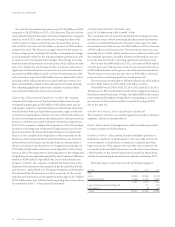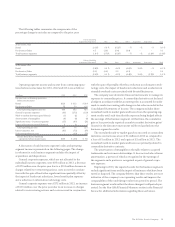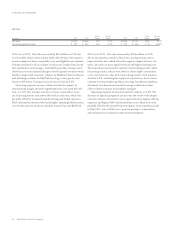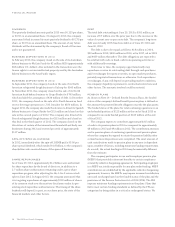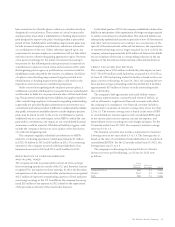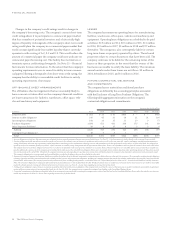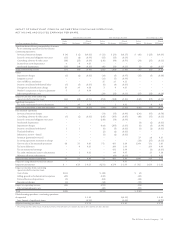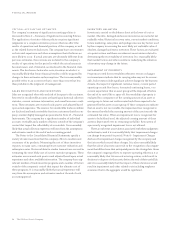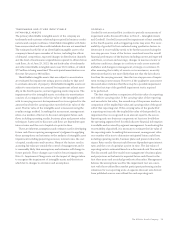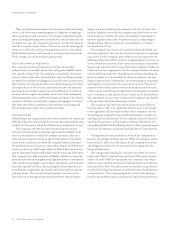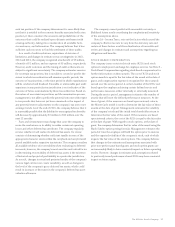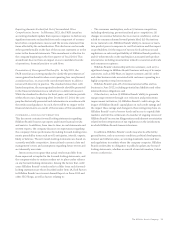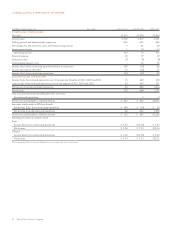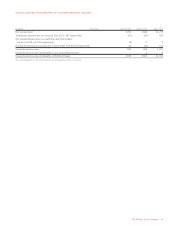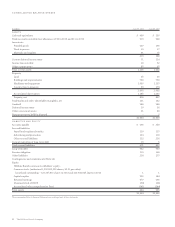Sara Lee 2013 Annual Report Download - page 24
Download and view the complete annual report
Please find page 24 of the 2013 Sara Lee annual report below. You can navigate through the pages in the report by either clicking on the pages listed below, or by using the keyword search tool below to find specific information within the annual report.
long-term debt. Market risk for fixed-rate long-term debt is estimated
as the potential decrease in fair value resulting from a hypothetical
10% increase in interest rates, which would result in a maximum
potential loss of approximately $16 million. The underlying fair values
of our long-term debt were estimated based on quoted market prices
or on the current rates offered for debt with similar maturities.
The company has interest rate risk associated with its pension
and post-retirement benefit obligations. Changes in interest rates
impact the liabilities associated with these benefit plans as well as
the amount of income or expense recognized for these plans. Declines
in the value of the plan assets could diminish the funded status of
the pension plans and potentially increase the requirements to make
cash contributions to these plans. See Note 16 – Defined Benefit
Pension Plans and 17 – Postretirement Healthcare and Life Insurance
Plans for additional information.
Commodities The company is a purchaser of certain commodities
such as beef, pork, chicken, packaging, fruit, seasoning blends, flour,
corn, corn syrup, soybean and corn oils, butter, sugar, natural gas and
diesel fuel. We also raise turkeys and contract with turkey growers
to meet our raw material requirements for whole birds and processed
turkey products. Our costs for turkey are affected by the cost and
supply of feed grains, including corn and soybean meal. Commodities
are subject to price risk due to factors such as fluctuations in the
commodity market, the availability of supply, severe weather,
consumer or industrial demand and changes in governmental and
international trade, alternative energy and agricultural programs.
The company attempts to reduce the market risk associated with
these by entering into either physical forward contracts or deriva-
tive instruments. The company has policies governing the hedging
instruments that can be used. In circumstances where commodity
derivative instruments are used, there is a high correlation between
the commodity costs and the derivative instrument.
For commodity derivative instruments held, the company uses
a sensitivity analysis technique to evaluate the effect that a 10%
change in the underlying commodity price would have on the market
value of the company’s commodity derivative instruments. The
impact is not significant compared with the earnings and equity
of the company.
In millions 2013 2012
Effect of a 10% change in market price
Grains & oilseeds $3 $7
Energy 3 2
Other commodities 2 2
22 The Hillshire Brands Company
FINANCIAL REVIEW
RISK MANAGEMENT ACTIVITIES
The company maintains risk management control systems to monitor
the interest rate and commodity risks, and the company’s offsetting
hedge positions. The risk management control system uses analytical
techniques including market value and sensitivity analysis.
Sensitivity Analysis The sensitivity analysis is the measurement
of the potential loss in future earnings, fair values or cash flows of
market sensitive instruments resulting from one or more selective
hypothetical changes in interest rates, foreign currency exchange
rates, commodity prices and other market rates or prices over a
selected time.
NON-GAAP FINANCIAL MEASURES
The following is an explanation of the non-GAAP financial measures
presented in this annual report. Adjusted net sales excludes from
net sales the impact of businesses that have been exited or divested
for all periods presented. Adjusted operating income excludes from
operating income the impact of significant items recognized during
the fiscal period and businesses exited or divested for all periods
presented. It also adjusts for the impact of an additional week in
those fiscal years that include a 53rd week. Results for businesses
acquired are included from the date of acquisition onward. Adjusted
EPS excludes from diluted EPS for continuing operations the impact
of significant items and the 53rd week.
SIGNIFICANT ITEMS AFFECTING COMPARABILITY
The reported results for 2013, 2012 and 2011 reflect amounts
recognized for restructuring actions and other significant amounts
that impact comparability.
Significant items are income or charges (and related tax impact)
that management believes have had a significant impact on the
earnings of the applicable business segment or on the total company
for the period in which the item is recognized, are not indicative of
the company’s core operating results and affect the comparability
of underlying results from period to period. Significant items may
include, but are not limited to: charges for exit activities; various
restructuring programs; spin-off related costs; impairment charges;
pension partial withdrawal liability charges; benefit plan curtail-
ment gains and losses; tax charges on deemed repatriated earnings;
tax costs and benefits resulting from the disposition of a business;
impact of tax law changes; changes in tax valuation allowances and
favorable or unfavorable resolution of open tax matters based on
the finalization of tax authority examinations or the expiration of
statutes of limitations.
The impact of the above items on net income and diluted earnings
per share is summarized on the following page.


